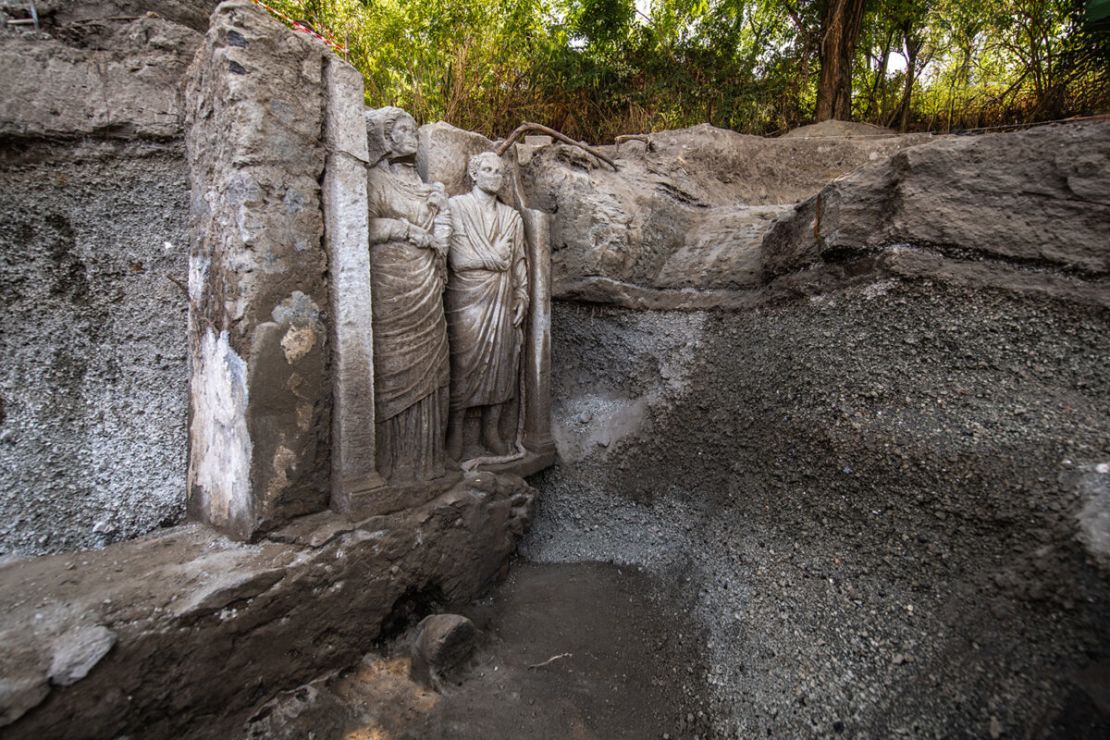Sign up for CNN’s Wonder Theory science newsletter. Explore the universe with news on fascinating discoveries, scientific advancements and more.
CNN
—
Two very rare, almost-life-sized statues have been discovered during the excavation of a massive tomb in Pompeii.
Archaeologists say the marble funerary statues of a toga-clad man and a woman shed new light on the power held by priestesses in the ancient city, which was destroyed when Mount Vesuvius erupted in 79 AD.
Unearthed during ongoing excavations of the tomb just outside the Porto Sarno entrance gates of the dead city, the statue of the woman is slightly taller than that of the man by her side.

She is wearing lavish jewelry including earrings, bracelets and rings, as well as a necklace with a crescent moon pendant like those worn by priestesses of the cult of Ceres – a goddess of fertility, agriculture and motherly relationships – the Pompeii archaeological park said in a statement announcing the discovery.
The “lunula,” or crescent moon pendant, was worn by priestesses to ward off evil forces from birth to marriage. “The symbol of the crescent moon also had an atavistic and primordial meaning, linked to the fertility of the earth, abundance and rebirth, and influenced by the lunar cycles,” according to the research paper on the discovery, published online.
The woman’s tunic is covered with a cape and she is holding what appears to be a papyrus roll and laurel leaves – often used for purifying and blessing religious spaces by dispersing the smoke from ceremonial incense throughout the area.
The woman’s adornments suggest she was more important than the man, according to Gabriel Zuchtriegel, director of the Pompeii archaeological park. This, he said, could mean they were not married but that the man may have been either a priest or the woman’s son.

The city of Pompeii was buried under ash and volcanic glass when Vesuvius erupted, and archaeologists have been unearthing it since the 1700s, in a large, ongoing excavation.
The current dig, called the Investigating the Archeology of Death in Pompeii Research Project, began in July 2024 and is led by Spanish archaeologist Llorenç Alapont, in conjunction with the University of Valencia and the archeological park.
The area was discovered in 1998 during the construction of a train line from Naples. So far, more than 50 cremation burial sites have been identified.
“This campaign is a precious opportunity to expand research and enhancement activities in the area outside the walls of Pompeii,” Zuchtriegel said in a press statement sent to CNN.
Previous discoveries in the same area include mummified remains. They were found in 2021 at the necropolis of Porta Sarno, in a tomb bearing a commemorative inscription dedicated to Marcus Venerius Secundio, a public slave and custodian of the Temple of Venus.
“Thanks to the collaboration with the University of Valencia, to which we also owe the discovery a few years ago of the Tomb of Marco Venerio Secundio in the same area, it was possible to work on a multidisciplinary project that saw the involvement of different professionals in the various phases, including archaeologists, architects, restorers, and anthropologists,” Zuchtriegel said.
The sculptures belong to what the archeologists working on the dig classify as a large class of funerary reliefs made between the first century BC and the first century AD, Alapont said.
These examples appear to date from the Late Republic era, between 133 and 31 BC, according to the research paper.
“Nevertheless, these types of sculptures are very rare in southern Italy. It is even more unusual to find reliefs of priestesses holding their religious objects,” Alapont said in the statement. “It is clear that there were priestesses of Ceres in Pompeii, but this statue provides new evidence of the importance of the cult in the city.
“In addition, the cult of Ceres has been linked to the popular classes. However, the ostentation of the female relief may suggest that the status of priestess was still reserved for women belonging to a relatively high social standing.”
The statues have been moved to the Palestra Grande, the largest open space in Pompeii, to be restored and will be featured in the exhibition “Being a Woman in Ancient Pompeii,” which opens in the archaeological park on April 16.

